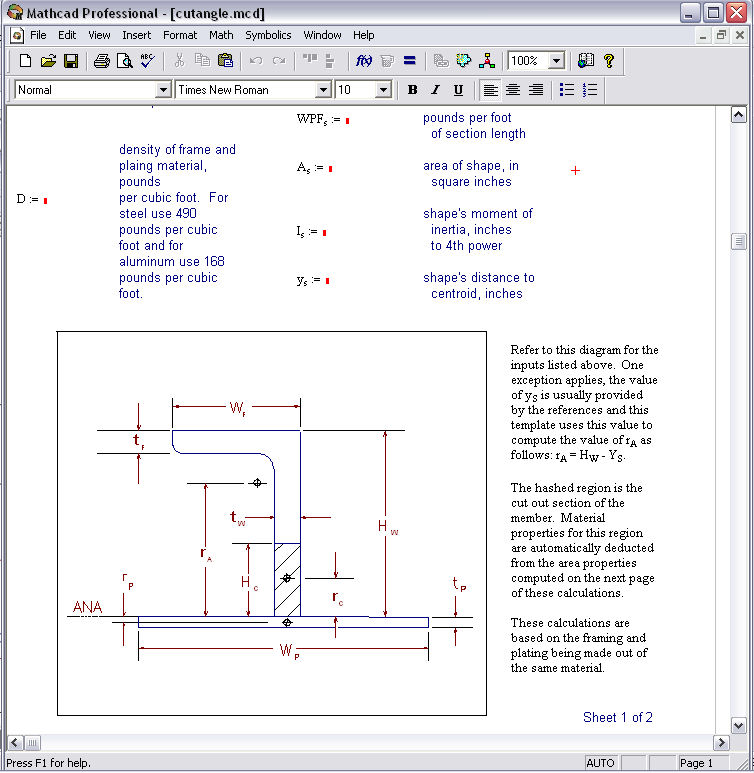Cut Angle and Plating Combined,
Framing Member Calculations (English Units)
Description:
This boilerplate template performs combined member area
property calculations. They include the property effects of the
cut angle framing member and also the plating to which this framing member is attached.
-
These calculations assume that a reference is
available that will provide the necessary area properties of the
framing member for insertion into this electronic calculation sheet for
computing the combined effects with plating attached.
-
This MathCAD document calculates the available
area properties such as section modulus and moment of inertia. It
does not calculate the required section modulus which is obtained
from sources similar to Reference B through D. In other words two
sets of calculations are needed. First the required section
modulus needs to be computed. Then some available framing members
are selected and their combined properties are computed on a electronic
document, like this template, to see if the available members meet or
exceed the required area properties.
-
This template applies to a frame that is cut to
accommodate a smaller framing member penetrating through it. These
computations deduct the area property effects of the material lost in this
notch.
-
The effective plating width, EPW, selected is the lesser
of the ABS allowable [1983 Rules for Steel Vessels under 200 feet (61
meters)], 38 times the plating thickness (an industry rule of thumb), or
the frame spacing (limited by geometry in this case). If other
classification society classing rules apply, these calculations should
be modified to suit applicable the classification society requirements.
-
These calculations apply to English units. But the
purchaser may change the template to apply to metric units.
-
The material for the framing member must be the same as for the plating member. Another approach is necessary
if this is not the case. In other words, this approach will work
for a steel frame on steel plating or an aluminum frame on aluminum
plating. It will not work for a aluminum frame on steel plating or
a steel frame on aluminum plating.
There are advantages and benefits to this calculative
method. First this approach saves you time. Many
computations are quickly done on your input data.
Second this approach provides clear and neat
documentation. These computations can readily be submitted to U. S.
C. G. or classification societies if requested. Third this approach
is cost effective because the calculative approach is already developed
for you, research time is minimized to familiarization of concepts if
necessary and not to time consuming development activities.
Electronic
Document Type: MathSoft
MathCAD
document Cost:
$7.50 US funds
Number of
Pages: Inputs Page, Outputs Page (2 MathCAD pages). Instructions
and Use Terms Page (1 browser page).
Inputs:
-
Geometric Properties of Framing Assembly
-
Support Length (or span) of framing member, inches
-
Support Width of framing member, inches
-
Height of Cut into framing member, inches
-
Angle Framing Member Properties, from reference texts,
diagram provided
-
Height of Web, inches
-
Thickness of Web, inches
-
Width of Flange, inches
-
Thickness of Flange, inches (if different from web
thickness)
-
Area, square inches
-
Area Centroid Distance, inches
-
Moment of Inertia, inches4
-
Unit Weight, pounds per foot
-
Plating Properties
-
Material Properties
Outputs:
Recommended
Reading:
Reference A: AISC Steel Construction Manual,
American Institute of Steel Construction, Chicago, IL.
-
Reference B: ABS Rules for Building and
Classing Steel Vessels Under 210 feet (61 meters), 1983, American
Bureau of Shipping, Houston, TX.
-
Reference C: Arthur Edmunds, Designing for
Power and Sail, Bristol Fashion Publications, 1998, Harrisburg, PA.
-
Reference D: John S. Spencer, Structural Design
of Aluminum Crewboats, Marine Technology, July 1975 Issue, Society
of Naval Architects and Marine Engineers, Paramus, NJ.
-
Reference E: Bruce Roberts-Goodson, The
Complete Guide to Metal Boats, International Marine, 2001, Camden,
ME.
-
Reference F: Dave Gerr, Boat Strength for
Builders, Designers and Owners, International Marine, 2000, Camden,
ME.
-
Reference G: Rawson and Tupper, Basic Ship
Theory, Longhams, London
-
Reference H: SNAME, Principles of Naval
Architecture, Society of Naval Architects and Marine Engineers,
Paramus, NJ.
-
any strength
of materials text
Terms:
Prior to purchase, read our End
User License Terms.
Download
Now: click the following hyperlink to pay
$7.50 fee and then immediately download the zip file containing the template.
Minimum
System Requirements: Windows 95/98/NT/2000/XP/Vista/Windows7
Sample:
A sample portion of a page is shown below.
|

